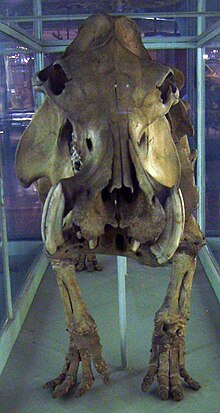Malagasy hippos
A number of now extinct hippopotamus species of the genus Hippopotamus that lived on the island of Madagascar are called Malagasy hippos . The fossil remains of three species have been discovered, at least one of which survived until a thousand years ago. They were close relatives of the recently living hippopotamus ( Hippopotamus amphibius ).

General
It is unclear when and how often the hippos reached Madagascar; accordingly, it is also controversial whether the three species represent a systematic unit or whether they represent more independent lineages.
All species survived into the Holocene , and their extinction was probably related to the colonization of Madagascar by humans. These reached the island around 1,500 years ago, and in the period that followed there was a mass extinction of larger animals, including some giant lemurs , elephant birds , the giant fossa and the Malagasy hippopotamus. Whether climatic changes also played a role is controversial. Some bones show traces of human processing, suggesting that humans and hippos were common in Madagascar for a while.
Oral traditions from the Malagasy people collected by Étienne de Flacourt in the 17th century and isolated reports could suggest that hippos lived longer on the island in remote regions. There are also reports from the 19th century, even from the 1970s, of a monster named Kilopilopitsofy, believed to resemble a hippopotamus. The veracity of these sightings is controversial and there are no independent confirmations.
The species
Hippopotamus laloumena
Hippopotamus laloumena is the largest Malagasy hippopotamus species. It was slightly smaller than the large hippopotamus that lived on the mainland , but otherwise very similar to it. So far, however, only a lower jaw and parts of the limb bones are known, which were found on the east coast and first described by Faure and Guerin in 1990 .
Hippopotamus Lemerlei
Hippopotamus lemerlei is known from several sites in the southern part of the island, most of which are close to the coast. This species reached a length of around two meters and a shoulder height of 81 centimeters, which roughly corresponds to the pygmy hippopotamus. The long skull and the eye sockets lying high on the head speak for an at least partially water-dwelling way of life, similar to the great hippopotamus. Noticeable differences in size in different skulls could be a sign of sex dimorphism . H. lemerlei was the first scientifically known Malagasy hippopotamus species, Alfred Grandidier described it in 1868.
Hippopotamus madagascariensis
Hippopotamus madagascariensis (Guldberg, 1883) is approximately the same size as H. lemerlei . The eye sockets further down on the skull and other features as well as the locations in the central, wooded highlands suggest a more rural way of life. Some studies see H. madagascariensis as a close relative of the pygmy hippopotamus, which still lives in West Africa, and assign the species to the same genus. Since the genus of the pygmy hippopotamus is controversial, both Hexaprotodon madagascariensis and Choeropsis madagascariensis are used as scientific names for the extinct species. If this species is actually closely related to the pygmy hippopotamus, this would be an indication that Madagascar has been colonized by hippos at least twice. But it is also conceivable that all Malagasy hippos had a common ancestor and that H. madagascariensis merely represents a convergent evolution to the pygmy hippopotamus .
literature
- Ronald M. Nowak: Walker's Mammals of the World. Johns Hopkins University Press, Baltimore MD et al. 1999, ISBN 0-8018-5789-9 .
See also
Web links
- Hippopotamus lemerlei and Hippopotamus madagascariensis onthe IUCN Red List of Threatened Species .
- Peter Grubb: The Afro-tropical Hippopotamuses - Hippopotamidae Hippopotamus and Hexaprotodon. In: Pigs, Peccaries and Hippos Status Survey and Action Plan. 1993, archived from the original on May 9, 2008 ; Retrieved May 3, 2013 .
